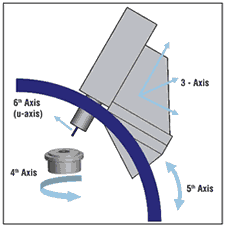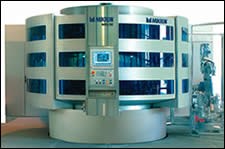Scalable Transfer Machine Offers Flexible Solutions
Mikron Machining Technology (Monroe, Connecticut) now offers the NRG-50 rotary transfer machine, which provides new dimensions in the cost-efficient production of large-volume series. The machines are designed for prismatic parts with an edge length of as much as 50 mm or, alternatively, 35-mm diameter and 70-mm length.
While transfer machines achieve maximum productivity in the manufacture of large volumes, component families with a production rate of several hundred thousand parts have increasing variations. Change-over on transfer machines has long been an issue, requiring complex procedures that are costly in time and labor. Modular transfer machines are now available that address these issues. One particular advantage of the modular concept is that it allows the customer to choose the most suitable, beneficial solution, between minimal cycle times, higher change-over flexibility and lower price.
Mikron Machining Technology (Monroe, Connecticut) now offers the NRG-50 rotary transfer machine, which provides new dimensions in the cost-efficient production of large-volume series. The machines are designed for prismatic parts with an edge length of as much as 50 mm or, alternatively, 35-mm diameter and 70-mm length. These machines are scalable when initially acquired or when changing over to other workpieces later. The customer has the advantage of choosing from a large selection of building blocks and order transfer machines from the manufacturer built to specific requirements.
Modular building blocks, designed to come together for optimal combined configurations, provide the flexibility required for high productivity. Because the combination possibilities are almost limitless, the Mikron NRG-50 is well suited for a wide application spectrum. The modular components are equipped with standard interfaces that connect them to the base machine and to the subsequent modular assembly groups. For example, the customer can choose from four different machining units, including vertical or horizontal units with three CNC axes each, a unit with four axes (additional rotating axis) and a single-axis unit, which can be optionally and freely positioned (suitable for drilling or threading). The units are mounted in the required angle to the workpiece and only perform the necessary feed stroke. The CNC-axis variations are programmed to perform the feed stroke on a linear or circular slide. The guided C axis also allows thread cutting without using a chasing head.
Operators can use the control to quickly reconfigure the machining units for different workpieces. These can be mounted on each workstation from above, below or from the outside, radially to the rotary table. A maximum of three working units on each of the 12 stations affords machining of the workpieces on the rotary table from three sides simultaneously. If interchangeable operations are necessary, as many as four tools from a magazine can be changed on each working unit. A maximum of 30 working units can be mounted on this machine, 22 of which can be equipped with ATC spindles carrying four tools each. The machine can work with a total of 96 cutting tools.
The user can take advantage of minimal change-over times—the equipment already has sufficient tools and machining options installed for machining a variety of workpieces. Even very complex workpieces requiring a variety of different tools can be machined in a single cycle or a single clamping. Also, auxiliary operations such as deburring can be integrated as a process step into the rotary transfer machine, considerably reducing machining costs. The machine is also designed for autonomous work, without operator assistance, using duplicate tooling.
The modular machine comes equipped with simple drill, mill, grind or thread cutting units on all workstations. For a higher degree of flexibility, a few four-axis CNC units are mounted next to the load and unload stations, allowing some more complex machining operations. The transfer machine can machine different workpieces with minimal change-over by using corresponding CNC programs, giving the machine almost the same flexibility as most traditional machining centers with the high productivity typical for a transfer machine. A crucial advantage of this machine is that the user can change from one task to another at any time simply by exchanging appropriate machining units and integrating the new working cycle into the CNC program.
The rotary table can be equipped with workpiece holding pallets (fixtures) in an axial or outside-mounted radial position. The vertical fixtures are especially suited for workpieces requiring many axial machining operations. The outside-mounted radial fixtures allow material to be loaded from bar. An angular table allows horizontal workpiece fixturing to be changed into vertical fixturing. An additional NC axis can later be added, facilitating indexing or OD or ID turning of workpieces. The machine is capable of complete machining of workpieces from six sides.
For high accuracy and repeatability, the machine is designed with advanced thermal stabilization to maintain constant temperature in the work area. For protection from damage caused by coolant, oil and chips, all drive and control elements are outside the enclosed machining area. Coolant liquid circulates in the machine’s body and keeps a constant temperature. Also, conditioned cooling air circulates through the working area. The hot chips and swarf are flushed quickly with the coolant through the funnel-shaped work area into a receiving tank.
The modular design and thermal stability of Mikron’s NRG-50 rotary transfer machine provide customers the options and performance necessary to address their needs now while keeping the flexibility to easily expand later when new jobs are acquired.
Related Content
Moen’s Flowing Success with Rotary Transfer Technology
The popular faucet manufacturer has adopted new CNC rotary transfer equipment to produce valves for its new generation of Widespread faucets.
Read MorePrecision Machining Technology Review: August 2024
Production Machining’s August 2024 technology showcase includes some of the latest technology from SW North America, Tsugami, Siemens, Select Manufacturing Technologies, Hurco and ECI Software Solutions — all on display at IMTS 2024.
Read MoreCNC Rotary Transfer Machine Features Ballscrew Electromechanical Tooling Units
A CNC rotary transfer machine, a newly developed machine platform, is said to offer high rigidity, flexibility and accuracy for a range of high-volume, precision-machining applications.
Read MorePMTS 2023 Product Preview: High-Volume Turning
Learn about some of the latest high-volume turning solutions that will be on display at PMTS 2023.
Read MoreRead Next
Seeing Automated Workpiece Measurement in Real Time
User-friendly inspection software for CNC machining centers was shown at IMTS 2024 monitoring measurements between and after machining while performing SPC based on recorded measurement values.
Read MoreDo You Have Single Points of Failure?
Plans need to be in place before a catastrophic event occurs.
Read More5 Aspects of PMTS I Appreciate
The three-day edition of the 2025 Precision Machining Technology Show kicks off at the start of April. I’ll be there, and here are some reasons why.
Read More
















.jpg;maxWidth=300;quality=90)








